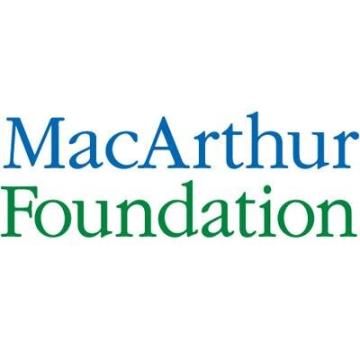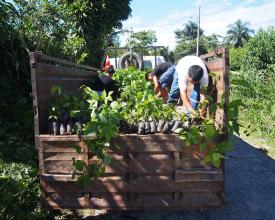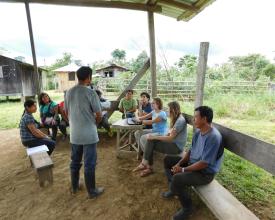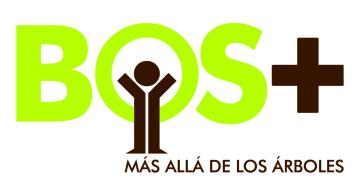
Fondation Runa L'agriculture au service de la biodiversité

S'appuyant sur les connaissances locales, Runa propose des formations aux agriculteurs indigènes afin d'atténuer les effets du changement climatique, de favoriser la biodiversité et d'améliorer les moyens de subsistance en créant une nouvelle valeur pour les produits forestiers et en améliorant l'accès aux marchés et la stabilité économique.
Runa soutient les agriculteurs en organisant des ateliers de renforcement des capacités afin de créer des plateformes de prise de décision et de gestion collectives. Ces initiatives permettent aux communautés locales de gérer leurs propres ressources, d'améliorer leurs moyens de subsistance, d'accéder au crédit, de restaurer la biodiversité et de protéger les traditions culturelles liées à leurs systèmes agroforestiers. La commercialisation des feuilles d' Ilex guayusa (un arbre originaire de l'Amazonie occidentale), consommées depuis des siècles par les populations indigènes de l'Amazonie équatorienne, en est un exemple. Le guayusa est connu pour ses propriétés énergétiques dues à sa forte concentration en caféine et en antioxydants.
Contexte
Défis à relever
Traditionnellement, les agriculteurs indigènes de l'Amazonie ont maintenu des systèmes agroforestiers "chakra" qui imitent la composition naturelle de la forêt, fournissant des cultures de subsistance aux familles et des habitats naturels à la flore et à la faune.
À la recherche de revenus supplémentaires, les agriculteurs sont de plus en plus contraints d'abandonner la méthode d'exploitation des chakras et de recourir à la production conventionnelle de cultures commerciales, au pâturage du bétail et à l'extraction du bois. Ces activités empiètent souvent sur les zones protégées, menaçant de nombreuses espèces et contribuant à la déforestation et à la dégradation. Rien qu'entre 1990 et 2010, l'Équateur a perdu au total 28,6 % de sa couverture forestière.
En outre, le développement des infrastructures dans la région, grâce à l'augmentation des programmes gouvernementaux et à la croissance démographique, a entraîné la déforestation et l'exploitation de zones auparavant isolées. Cela a conduit à la fragmentation des forêts, créant de petites poches de biodiversité qui limitent le mouvement de la faune et créent des régions plus sensibles à l'impact de l'homme.
Emplacement
Traiter
Résumé du processus
Nos éléments fondamentaux, à savoir la création de chaînes de valeur durables basées sur la biodiversité locale (BB 2) et le renforcement des associations d'agriculteurs (BB 1), interagissent les uns avec les autres pour créer une capacité locale à concevoir des stratégies basées sur les réalités locales, qui protègent les écosystèmes et qui améliorent les moyens de subsistance. Lorsque l'on travaille avec des associations locales d'agriculteurs pour créer de nouvelles chaînes de valeur, il est essentiel que l'association ait la capacité de gérer ses activités de production et de devenir une entité autosuffisante. Il est important que tous les acteurs perçoivent la viabilité et les avantages du travail et se sentent capables d'assumer leurs rôles et leurs responsabilités. Nous travaillons directement avec les agriculteurs et leurs dirigeants pour renforcer leur organisation par le biais d'ateliers, d'échanges de connaissances et d'une assistance technique visant à améliorer la capacité de l'association elle-même afin qu'elle puisse gérer efficacement sa participation à la chaîne de valeur. Grâce à ces activités et à une collaboration directe avec divers acteurs locaux, nous pouvons créer des chaînes de valeur viables basées sur les connaissances locales et les exigences des marchés internationaux.
Blocs de construction
Renforcement des associations d'agriculteurs
La stratégie de développement communautaire de la Fondation Runa consiste à créer des organisations et des associations communautaires fortes, capables d'investir de l'argent et des ressources dans leur propre développement afin d'améliorer leurs moyens de subsistance. Au cours des trois dernières années, les associations de producteurs de guayusa ont beaucoup progressé sur le plan organisationnel. Contrairement à d'autres régions d'Amérique latine, les coopératives agricoles n'ont pas une longue histoire en Amazonie équatorienne. Dans ce contexte, nous avons donné la priorité à la certification du commerce équitable et au renforcement des capacités des agriculteurs en matière d'organisation et de gestion des ressources, afin de garantir que les producteurs indigènes soient en mesure de se connecter aux marchés d'une manière juste et équitable. L'un des principaux facteurs de réussite dans la création d'associations de producteurs a été d'imiter le fonctionnement des structures de gouvernance actuelles utilisées localement pour gérer les communautés, les terres ou les ressources. Au lieu d'imposer une structure qui a fonctionné avec succès dans d'autres régions d'Amérique latine, les producteurs déterminent la structure et la fonction de leurs associations, et nous travaillons avec eux pour construire un système de gouvernance qui soit efficace et légitime aux yeux des producteurs.
Facteurs favorables
Les progrès des associations peuvent être attribués en partie à la participation et à l'adhésion des acteurs locaux, qui créent et définissent une structure de travail pour la planification, la coordination et le suivi des progrès des associations. Une structure flexible et capable de s'adapter aux besoins des associations individuelles est essentielle, ce qui nécessite souvent d'investir plus de temps et de ressources pour organiser des réunions ou des ateliers supplémentaires afin de s'assurer que les associations renforcent leur capacité à progresser de manière durable.
Leçon apprise
Il est parfois difficile de motiver les associations à participer aux nombreuses activités nécessaires à la certification de leur produit. Pour les cultures établies telles que le café et le cacao, les volumes d'achat prévus, les prix plus élevés et les marchés établis pour les produits certifiés contribuent à garantir que les ventes et la contribution à la prime sociale de leur certification de commerce équitable constituent une incitation suffisante. Toutefois, s'agissant d'un nouveau produit, le manque de stabilité du marché compromet la participation continue et de qualité des producteurs et des associations. Nous avons également appris l'importance de créer des mécanismes de collaboration entre tous les acteurs impliqués dans la chaîne de valeur et d'établir des lignes directrices claires pour diriger notre travail. Pendant plusieurs années, nous avons collaboré directement avec les associations ainsi qu'avec les acteurs des secteurs privé et public et nous avons analysé et révisé les différentes activités impliquées dans la chaîne de valeur de la guayusa en utilisant une approche de gestion adaptative qui s'est avérée très fructueuse pour ce travail de collaboration.
Construire des chaînes de valeur durables basées sur la biodiversité locale
Runa travaille à la mise en place de chaînes de valeur durables pour des produits innovants basés sur la biodiversité locale. Runa se concentre sur les produits qui sont emblématiques de la culture locale et qui ont une histoire d'utilisation et de production durable au sein des communautés indigènes avec lesquelles nous travaillons. Runa aide les producteurs locaux à accéder à une variété d'opportunités de marché qui équilibrent les activités à valeur ajoutée, l'accès stable au marché et la possibilité de vendre localement toute production excédentaire. Runa travaille avec les communautés pour créer des espaces permettant aux petits exploitants agricoles de transformer les systèmes de production traditionnels en moyens de subsistance durables.
Facteurs favorables
Le succès de Runa dans le développement de chaînes de valeur durables peut être attribué à la collaboration avec les locaux pour utiliser leurs vastes connaissances des produits agricoles et forestiers non ligneux et des techniques de production, ainsi qu'à la demande existante sur les marchés internationaux pour des produits nouveaux et exotiques. Bien que les nouvelles chaînes de valeur nécessitent des investissements en temps et en ressources, Runa a été en mesure de fournir un soutien financier et de renforcement des capacités et d'assumer des risques qui, autrement, pourraient être encourus par les agriculteurs et entraver leur participation ou la réussite du projet.
Leçon apprise
Afin de créer des chaînes de valeur durables basées sur la biodiversité, Runa reconnaît l'importance de travailler directement avec les producteurs pour développer des stratégies et formaliser les meilleures pratiques pour les petits exploitants agricoles. Notre analyse montre qu'au cours des premières années de développement du marché pour une nouvelle culture, il est peu probable que les forces du marché puissent à elles seules encourager une production écologique et socialement durable, en particulier telle que dictée par le commerce équitable et les normes biologiques de l'USDA. Un soutien supplémentaire est nécessaire pour couvrir les coûts requis pour atteindre les impacts sociaux et écologiques pendant que la durabilité économique se développe. Nous avons également appris qu'une forte demande et des prix stables sont nécessaires pour que les agriculteurs investissent dans l'adoption de nouvelles pratiques de gestion afin d'améliorer la production. L'accès d'un agriculteur à un marché stable et la certitude qu'il pourra vendre sa récolte le rendent plus enclin à prendre le risque d'expérimenter de nouvelles techniques sans craindre la perte économique d'une activité génératrice de revenus.
Impacts
La Fondation Runa soutient la biodiversité et a un impact positif sur l'environnement local de trois manières principales.
1) La création d'opportunités économiques viables pour les produits forestiers non ligneux et les produits agroforestiers biologiques augmente le revenu global, réduisant ainsi la nécessité d'activités agricoles non durables. Les efforts que nous déployons pour accroître la production durable dans les zones tampons ont pour effet de réduire l'empiètement sur les zones protégées.
2) Runa encourage la production d'Ilex guayusa dans des systèmes agroforestiers à usage mixte, qui présentent une plus grande biodiversité que les systèmes agricoles conventionnels. Une étude portant sur la diversité et la productivité des systèmes agroforestiers mixtes a révélé que les polycultures améliorent la résistance des cultures aux pressions environnementales en augmentant la diversification écologique et en réduisant la dégradation des sols grâce au cycle naturel des nutriments et à la réduction des perturbations humaines. La prolifération de ces systèmes favorise le maintien des populations locales de flore et de faune, car ces systèmes imitent la composition naturelle des forêts.
3) En complément de nos initiatives agricoles, notre programme travaille avec les communautés pour créer des plans de paysage intégrés qui comprennent des stratégies pour une meilleure gestion des ressources, ainsi que pour la reforestation et la restauration. Ce programme a permis d'intégrer plus de 56 000 hectares dans des plans de gestion durable, avec 150 hectares de reboisement et de restauration planifiés.
Bénéficiaires
Les bénéficiaires de cette initiative sont les agriculteurs indigènes kichwa de l'Amazonie équatorienne. Grâce à cette initiative, une nouvelle valeur est créée pour les produits forestiers, qui est durable sur le plan environnemental et qui améliorera les moyens de subsistance des agriculteurs locaux.
Objectifs de développement durable
Histoire
Maira Pisango est présidente de l'association de producteurs UCKAR et vit dans la communauté Kichwa de San Rafael. Elle travaille avec la Fondation Runa depuis 2010 et a été élue présidente des producteurs de guayusa dans sa région. Elle facilite la gestion et l'investissement du fonds de primes sociales, généré par la vente de guayusa certifiée équitable. Sa première grande réalisation a été d'acheter des fournitures agricoles pour les membres de son association, et elle travaille actuellement à l'obtention d'un statut juridique pour son association. En tant que femme dirigeante, Maira est un modèle et une pionnière dans sa communauté. Elle excelle à gérer les besoins de ses électeurs et est également connue pour sa chaleur et son ouverture d'esprit. Devenir une dirigeante a changé son statut au sein de la communauté ; elle voyage désormais, dirige des réunions et se réjouit de son rôle de personnalité publique. "Avant [de devenir leader], je restais à la maison, j'avais peur, j'étais intimidée à l'idée de parler devant un groupe, de répondre à des questions. La possibilité d'assumer un rôle de leader a transformé de nombreux aspects de sa vie. Maira a grandi dans une situation commune à de nombreuses femmes rurales kichwa. Faisant partie d'une famille de 12 enfants et étant une fille, ses parents n'étaient pas en mesure de subvenir à ses besoins. Comme beaucoup de femmes de sa génération, elle n'a pas dépassé le stade de la huitième année d'études lorsqu'elle s'est mariée. Mais avec le soutien de son mari, elle a pu terminer ses études secondaires tout en élevant ses deux premiers enfants. Lorsqu'elle a exprimé le souhait de devenir dirigeante, son mari a essayé de l'en empêcher, car il ne voulait pas que son travail interfère avec ses responsabilités ménagères. Cependant, il a changé d'avis après avoir vu tout ce qu'elle a gagné dans son rôle. Elle déclare fièrement : "Je suis maintenant un exemple pour mes enfants". Son mari travaille sur des chantiers de construction et, lorsqu'il est entre deux emplois, elle l'emmène avec elle aux réunions et aux formations. Dans ses emplois précédents, elle a mentionné avoir été confrontée au racisme et à l'exploitation, comme de nombreuses femmes kichwa. En revanche, son travail avec Runa a été à la fois satisfaisant sur le plan professionnel et personnel et lui a permis d'accéder au monde professionnel, ce qui est une opportunité rare pour les femmes des zones rurales ayant un faible niveau d'éducation. Maira insiste constamment sur l'importance de l'éducation, qui constitue la principale dépense du ménage. Les formations qu'elle a suivies en tant que responsable l'ont aidée à poursuivre sa propre éducation et à acquérir des compétences précieuses. Maira est impatiente de continuer à travailler et d'aider les producteurs à accéder à de nouveaux marchés pour la vente de leur guayusa.





